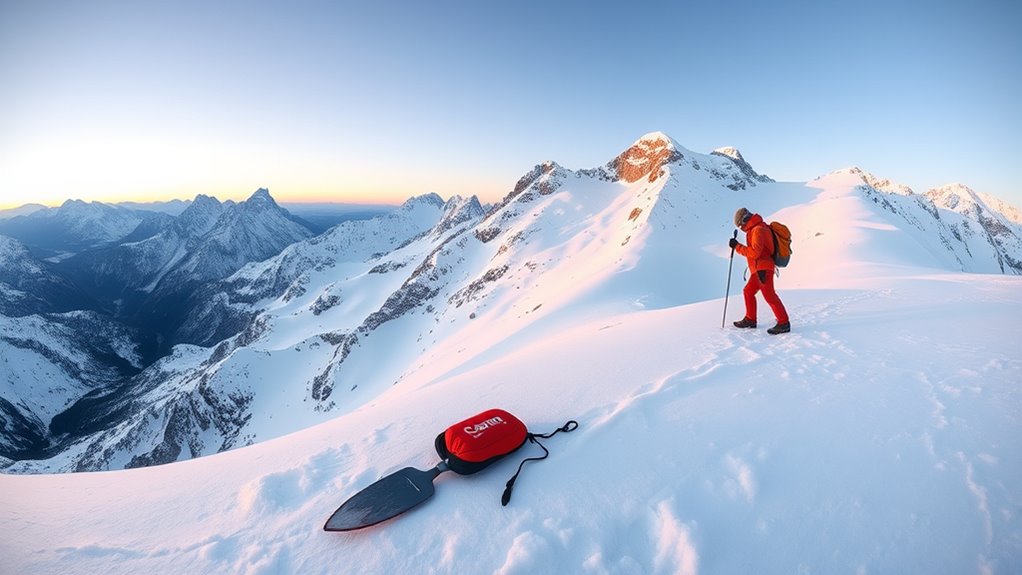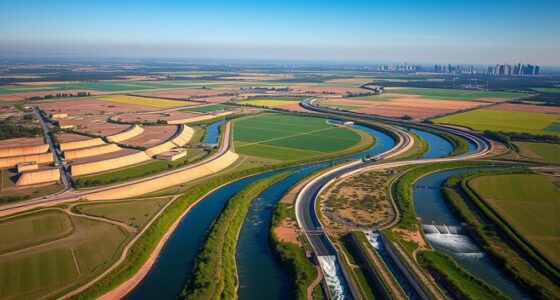To prepare for avalanches, learn to recognize warning signs like cracking snow, recent slides, and hollow sounds. Always carry essential safety gear such as avalanche beacons, shovels, and airbags, and know how to use them effectively. Plan your route carefully, avoiding steep slopes and terrain traps, and monitor weather and snowpack conditions continuously. Practicing rescue techniques and maintaining communication tools boost your safety. Staying aware of these measures increases your chances of staying safe—stay with us to see how to master them.
Key Takeaways
- Check avalanche forecasts, assess terrain hazards, and identify signs of snowpack instability before heading out.
- Carry essential safety gear such as avalanche beacons, shovels, and airbags; ensure all equipment is functional and accessible.
- Plan routes to avoid steep slopes, terrain traps, and recent avalanche areas; remain adaptable to changing weather conditions.
- Practice rescue techniques, including probe and shovel methods, and establish communication plans with your team.
- Stay alert for warning signs like cracking, whumpfing sounds, and hollow snow, and respond immediately to unsafe conditions.
Understanding Avalanche Types and Conditions
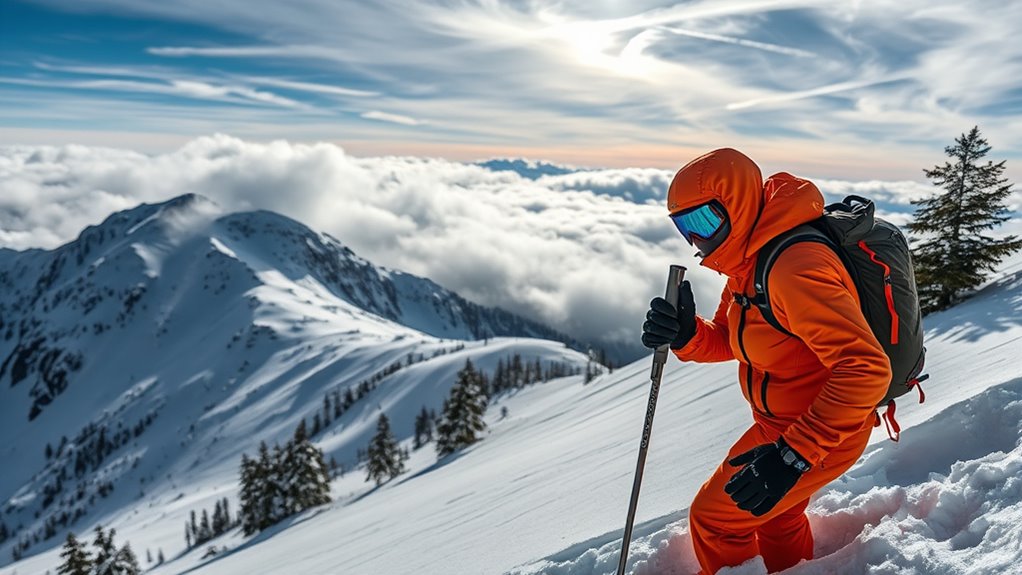
Have you ever wondered what causes different types of avalanches? It all comes down to snowpack stability and the conditions that lead to avalanche triggering. When the snowpack becomes weak or layered, it’s more prone to sliding. Heavy snowfall, rapid temperature changes, or new snow can destabilize the snowpack, increasing the risk of avalanches. Different avalanche types, like slab or loose snow, depend on how the snowpack breaks apart. Recognizing these conditions helps you understand when an avalanche might occur. You can’t always predict exactly when avalanche triggering will happen, but observing signs of instability—such as cracking or hollow sounds—can warn you of potential danger. Knowing the types and conditions of avalanches is vital for safety in snow-covered terrains. Understanding avalanche behavior can further improve your safety awareness in such environments. Additionally, awareness of avalanche forecasting methods can help you assess risk levels more accurately before venturing into risky areas. Being familiar with snowpack layers and how they interact under different weather conditions can also aid in predicting avalanche likelihood. Moreover, understanding how weak layers form within the snowpack can provide deeper insight into potential failure points. Recognizing snowpack stability and how it changes over time is essential for effective avalanche risk management.
Recognizing Avalanche Warning Signs
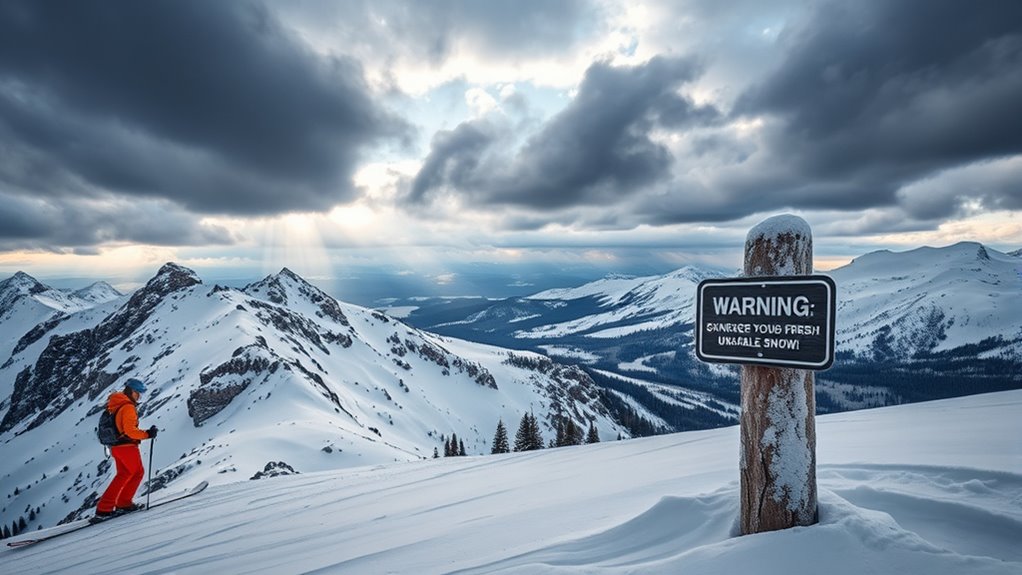
Recognizing avalanche warning signs is essential for staying safe in snow-covered terrain. You need to monitor the snowpack stability and observe weather patterns, as changes can trigger avalanches. Look for signs like recent avalanches, cracking snow, or whumpfing sounds indicating instability. Pay attention to weather conditions—heavy snowfall, rain, or rapid temperature changes weaken the snowpack. Use this table to identify warning signs:
| Warning Sign | Explanation |
|---|---|
| Cracking sounds | Snow begins to fracture underfoot |
| Whumpfing noises | Sudden collapse of weak snow layers |
| Recent avalanches | Indicates active instability in the area |
| Unusual snow surface | E.g., loose or wind-blown snow |
| Temperature swings | Rapid changes affect snowpack stability |
Staying aware of snowpack stability and understanding these indicators can significantly reduce risk. Recognizing avalanche terrain factors can also influence the likelihood of a slide, making terrain assessment crucial. It is also important to consider weather patterns, which can impact snow conditions and stability. Monitoring refrigerants and environmental impact in snowpack chemistry can provide insights into potential weak layers. Additionally, paying attention to headphone safety when listening to devices during outdoor activities can help maintain awareness in critical situations. Stay vigilant and trust your observations to stay safe.
Essential Safety Gear for Backcountry Travel
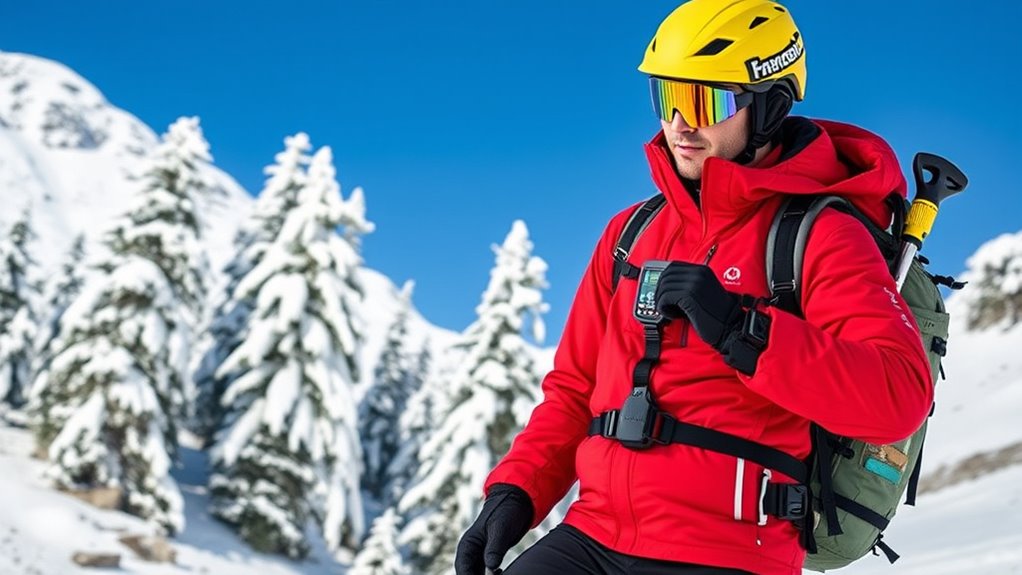
When heading into backcountry areas, you need to have the right safety gear to protect yourself. Knowing how to use an avalanche beacon, mastering shovel techniques, and understanding how an airbag system works can make all the difference. These tools are essential for increasing your chances of survival if an avalanche occurs. Additionally, familiarizing yourself with vetted Halloween product reviews can help you choose reliable gear and accessories for your safety kit. Staying informed about technological advances in creative tools can also aid in developing emergency plans and improving your preparedness. Understanding Gold IRA options and strategies can further enhance your financial safety net in unpredictable situations. Proper installation and maintenance of your safety equipment is crucial to ensure it functions correctly when needed. Incorporating AI-driven safety monitoring tools can provide real-time alerts and improve response times during emergencies.
Avalanche Beacon Usage
An avalanche beacon is an essential piece of safety gear that can dramatically increase your chances of being found quickly in an emergency. To guarantee it works effectively, regularly perform beacon maintenance, checking batteries and functionality. Understanding your beacon’s signal range is vital; most have a range of 40 to 50 meters, but this can vary. When using your beacon, keep it switched on and set to transmit mode. Practice switching between search and send modes so you’re prepared. Remember, a well-maintained beacon increases your safety and improves rescue efficiency. Additionally, familiarize yourself with mindfulness techniques to stay calm and focused during emergency situations, which can be crucial for effective rescue operations. Incorporating safety standards into your gear checks can further ensure reliability during critical moments, especially considering the importance of rescue preparedness that emphasizes thorough planning and resilience in challenging circumstances.
Proper Shovel Techniques
Proper shovel techniques are essential for efficient and safe rescue efforts during a snow emergency. Using good shovel ergonomics helps prevent fatigue and injury, so keep your back straight and bend at the knees. When digging, focus on proper techniques: use your legs rather than your back, and take small, controlled scoops to conserve energy. Clear snow around the victim’s head and chest first, working systematically to expose their airway. Keep the shovel close to your body to maintain balance and leverage. If you need to dig a wider hole, switch your grip and stance to avoid strain. Practicing these digging techniques beforehand ensures you’re prepared to act quickly and safely in high-pressure situations. Additionally, understanding QA best practices can help ensure your rescue efforts are effective and compliant with safety standards. Being familiar with proper avalanche safety protocols can further enhance your preparedness during backcountry travel. Developing a rescue plan beforehand can significantly improve response times and efficiency during emergencies. Incorporating appropriate safety gear, such as helmets and avalanche probes, is also crucial for safety during rescue operations. Remember that proper safety measures can make the difference between a successful rescue and a tragic outcome.
Avalanche Airbag Systems
Have you considered how avalanche airbag systems can substantially increase your chances of survival in backcountry terrain? These systems are designed for quick airbag deployment during an avalanche, helping you stay near the surface and avoid deep burial. Proper safety training is essential to ensure you know how to deploy the airbag swiftly and effectively when needed. Familiarize yourself with the device’s mechanisms, practice airbag deployment regularly, and understand its limitations. An airbag system isn’t a substitute for safe travel practices but a valuable safety gear addition. When used correctly, it can considerably reduce burial depth and improve rescue chances. Remember, investing time in safety training and practicing deployment can make all the difference in a life-threatening situation.
Planning and Preparing Your Route
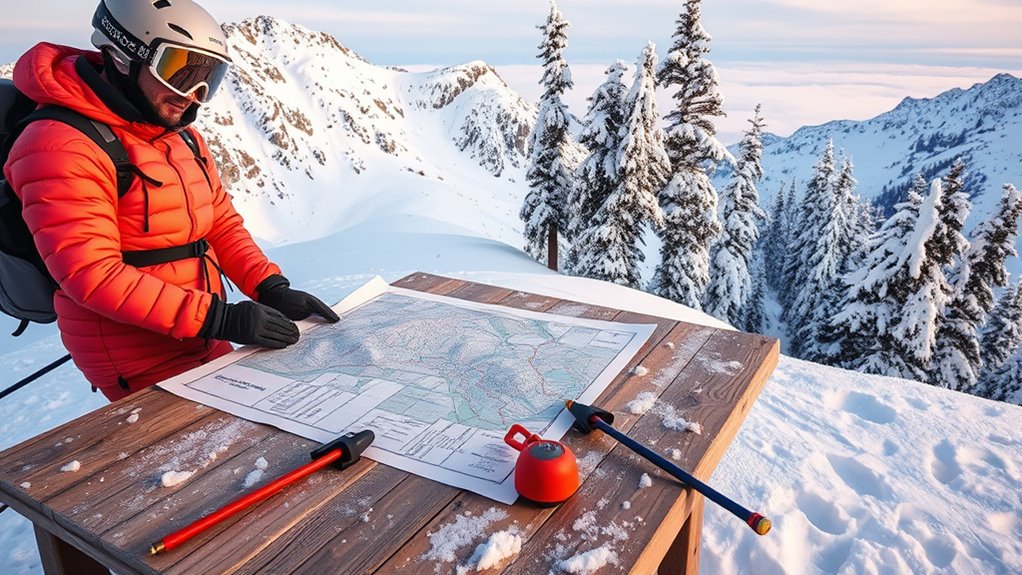
Before heading out, you should map your route carefully to understand the terrain you’ll encounter. Always check avalanche risk levels along your path to avoid dangerous areas. Proper planning helps you stay safe and make quick decisions if conditions change.
Map Your Path
Planning and preparing your route is essential to stay safe in avalanche terrain. Proper route planning involves evaluating the terrain carefully to avoid avalanche-prone areas and choosing safe pathways. Conduct a terrain assessment by identifying slopes, ridges, and valleys that are less likely to trigger avalanches. When mapping your path, consider:
- Avoiding steep slopes over 30 degrees
- Staying clear of terrain traps like gullies and cliffs
- Maneuvering through low-risk, flat, or gentle slopes
Check Avalanche Risks
How can you make certain your route remains safe from avalanches? The key is thorough risk assessment before heading out. Start by checking current avalanche forecasts and recent weather patterns, as these influence avalanche prevention. Look for signs of instability, such as recent snowfalls or temperature fluctuations. Avoid slopes with a high avalanche risk, especially those steeper than 30 degrees. Use tools like an avalanche beacon, probe, and shovel to prepare for rescue efforts. Remember, understanding terrain features and snowpack conditions helps you evaluate danger levels. Always stay alert and adjust your route if conditions change. Proper risk assessment reduces the chances of triggering an avalanche and guarantees you’re better prepared to respond swiftly if an avalanche occurs.
Techniques for Avalanche Rescue and Survival
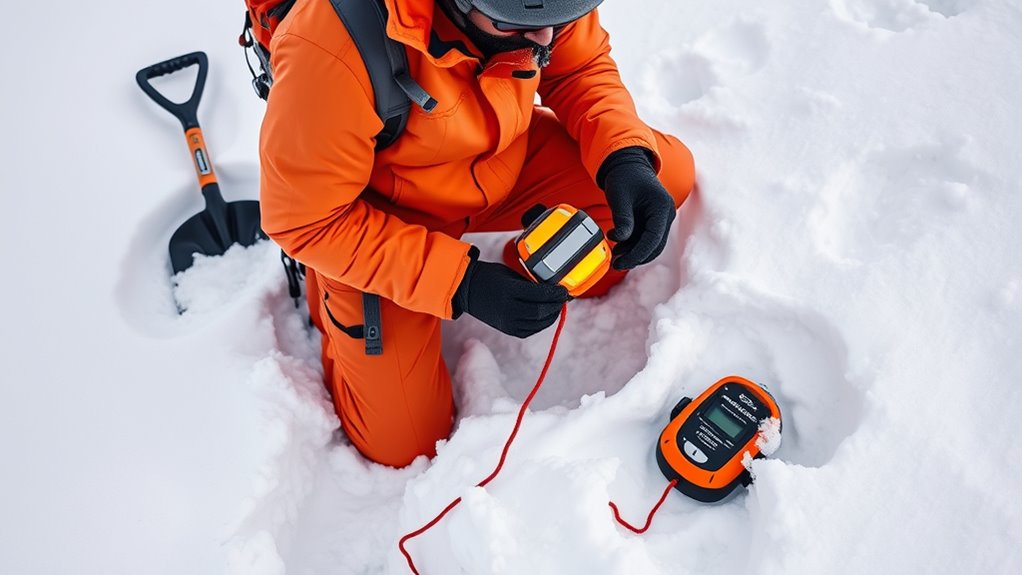
When caught in an avalanche, quick and effective rescue techniques can mean the difference between life and death. Your first priority is to locate and dig out buried victims swiftly. Use rescue techniques like probing with a collapsible pole or using a hand shovel to clear snow around the victim’s face and chest. Remember, staying calm helps conserve energy and improves decision-making. To maximize survival chances, follow these survival strategies:
In an avalanche, swift rescue and calmness are key to survival.
- Keep your airway clear and try to remain calm to conserve oxygen.
- Create an air pocket if trapped, to breathe until help arrives.
- Signal rescuers by making noise or using a whistle if possible.
Practicing these rescue techniques and survival strategies beforehand increases your chances of survival and helps others locate you faster.
Communicating and Staying Connected in Remote Areas
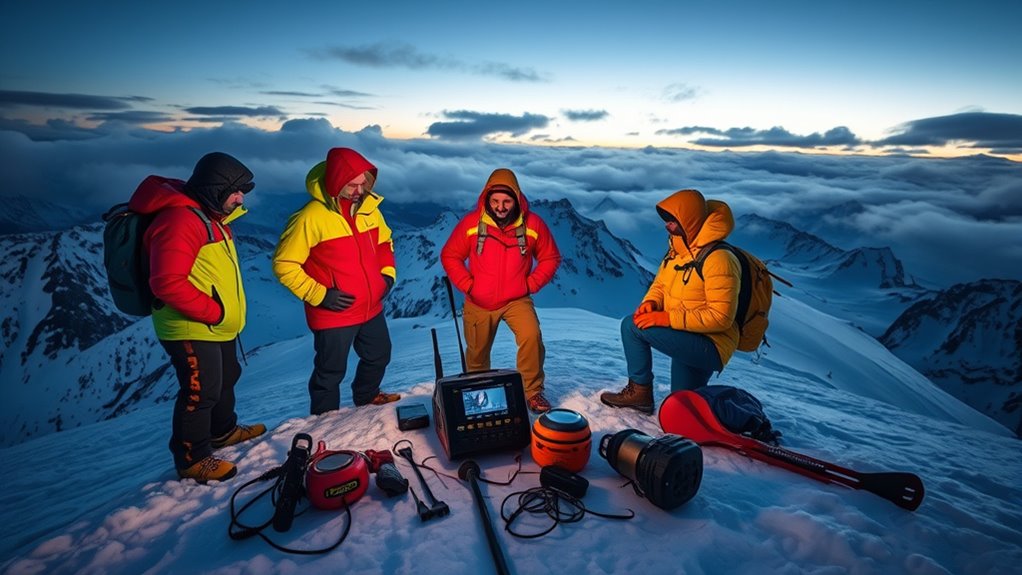
Have you ever found yourself in a remote area where cell service is nonexistent? Staying connected becomes essential in such situations. Satellite communication devices allow you to send and receive emergency messaging even without cell towers. These devices are compact and reliable, guaranteeing you can reach rescue services or loved ones when needed. Make certain to carry a satellite communicator if you’re venturing into isolated regions. Familiarize yourself with its functions before heading out. In emergencies, quick access to emergency messaging can be lifesaving, providing your location and situation details to rescuers. Staying connected through satellite tech minimizes panic and delays, giving you peace of mind. Always test your communication gear beforehand to verify it works properly in case of an emergency.
Responding Effectively During an Avalanche Emergency
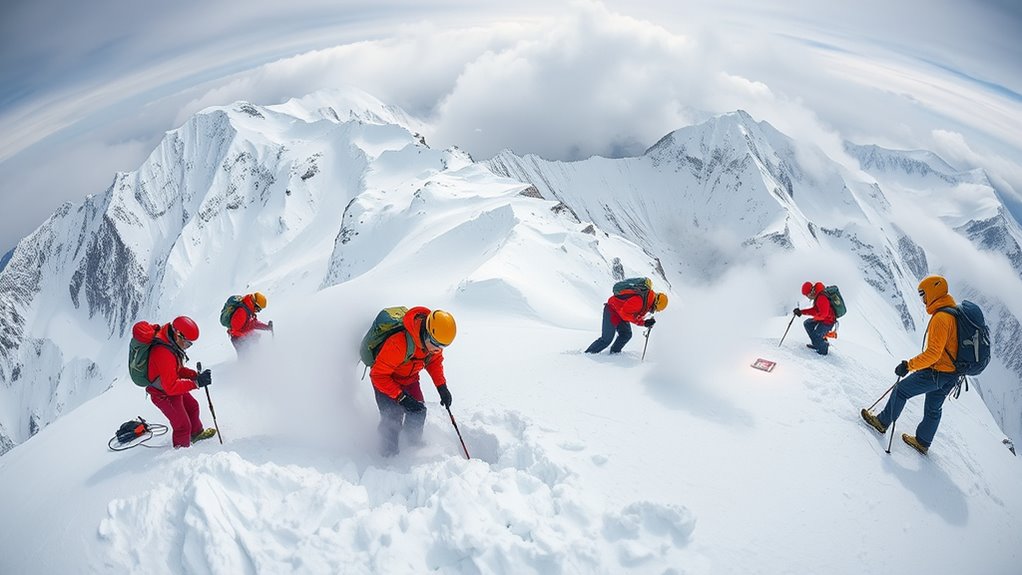
In an avalanche emergency, quick and decisive action can mean the difference between survival and disaster. Your priority is to locate and assist buried victims using effective rescue strategies. Keep calm and listen for signs of movement or voices. Use a probe or your hands to carefully search for trapped individuals. Once found, stabilize the victim’s airway and prevent shock with proper first aid techniques. If you’re trained, carefully dig them out, avoiding further injury. Remember, swift action is essential, but safety comes first — never put yourself at risk.
- Assess the victim’s condition quickly and provide CPR if needed
- Keep them warm and shielded from the cold environment
- Signal for help and coordinate rescue efforts efficiently
Post-Avalanche Safety and Recovery Measures

After ensuring everyone is safe and the injured are cared for, attention shifts to post-avalanche safety and recovery. Start by evaluating snow stability through thorough snow stability analysis to identify remaining risks. Use avalanche forecasting tools to monitor weather and snowpack conditions, helping you determine if it’s safe to proceed or if hazards persist. Keep clear of unstable slopes and avoid areas with recent avalanches. Communicate with others about your findings and establish a safe plan for recovery. Check for potential secondary avalanches, especially in unstable snow zones. Once you’re confident the terrain is safe, slowly resume movement, staying alert for signs of further instability. Prioritize safety, stay informed, and avoid rushing back into risky areas until conditions are confirmed stable.
Frequently Asked Questions
How Can I Improve My Avalanche Prediction Skills?
To improve your avalanche prediction skills, focus on mastering avalanche forecasting and hazard assessment. Study weather patterns, snowpack stability, and terrain features regularly. Use tools like avalanche bulletins and reports from experienced forecasters. Practice evaluating snow layers and identifying signs of instability. Stay updated with current research and attend training courses. By honing these skills, you’ll become more confident in anticipating avalanche risks and making safer decisions in the mountains.
What Psychological Effects Can Occur After an Avalanche Incident?
Imagine a storm’s aftermath settling softly on your mind, subtly shaping your thoughts. After an avalanche, you might experience post trauma symptoms like flashbacks or anxiety, challenging your emotional resilience. These psychological effects can feel overwhelming, yet with time and support, you can rebuild your inner strength. Recognizing these feelings helps you process the experience, turning emotional scars into sources of resilience and growth.
Are There Specific Training Programs for Avalanche Rescue?
Yes, there are specific training programs for avalanche rescue. You can participate in rescue drills and certification courses designed to improve your skills. These programs often include hands-on practice with beacon searches, probe deployments, and shoveling techniques. By completing these courses, you’ll gain the confidence and knowledge needed to effectively respond in emergencies, increasing your safety and the safety of others during an avalanche incident.
How Do Weather Patterns Influence Avalanche Risk?
Weather patterns paint a shifting canvas, revealing the danger beneath your feet. When warm air meets cold snow, it weakens the snowpack stability, increasing avalanche risk. Meteorological forecasting acts like a crystal ball, helping you anticipate these changes. Sudden storms or rapid temperature rises can trigger slides, so pay close attention to weather reports. Understanding these patterns keeps you one step ahead, turning nature’s chaos into your safety net.
What Legal Considerations Exist for Avalanche Safety Interventions?
When considering avalanche safety interventions, you must understand legal liability and regulatory compliance. You’re responsible for ensuring your actions don’t breach laws or safety regulations, which can lead to legal consequences if accidents occur. Always check local regulations, obtain necessary permits, and document safety measures taken. By adhering to legal standards, you protect yourself and others while effectively managing avalanche risks, ensuring safety efforts are lawful and accountable.
Conclusion
As you venture into snow-covered peaks, remember that your awareness is your shield. Stay alert to warning signs, equip yourself with the right gear, and plan each step carefully. In an avalanche’s icy grip, quick thinking and calm action can make all the difference—like a torch cutting through the storm. By staying prepared and confident, you’ll transform a treacherous landscape into a safe adventure, where every breath of crisp mountain air feels like a victory.

